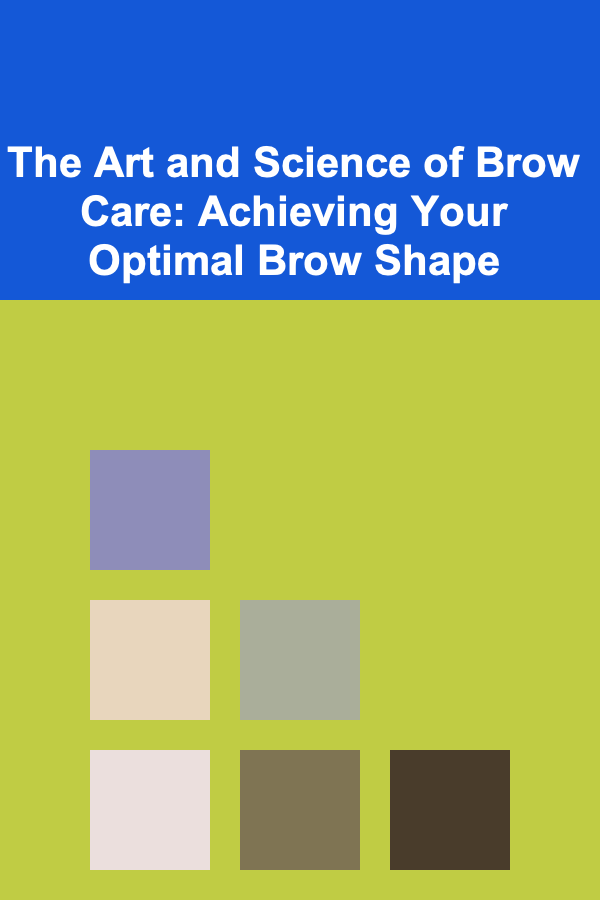
The Art and Science of Brow Care: Achieving Your Optimal Brow Shape
ebook include PDF & Audio bundle (Micro Guide)
$12.99$6.99
Limited Time Offer! Order within the next:

Eyebrows are more than just strands of hair above our eyes; they are a crucial element of facial expression, playing a significant role in framing the face and enhancing our overall appearance. Well-groomed and appropriately shaped brows can accentuate our features, balance our face shape, and even convey emotions more effectively. Conversely, neglected or poorly shaped brows can detract from our appearance, making us look tired, older, or unbalanced.
In this comprehensive guide, we'll delve into the art and science of brow care, exploring the various techniques, tools, and considerations involved in achieving your optimal brow shape. We will cover everything from understanding your natural brow shape and face shape to choosing the right shaping method and maintaining healthy brow growth. Whether you're a complete beginner or a seasoned brow enthusiast, this guide will provide you with the knowledge and tools you need to achieve brow perfection.
Understanding Your Brow Anatomy and Face Shape
Before you even think about tweezing, waxing, or threading, it's essential to understand the basic anatomy of your eyebrows and how they relate to your face shape. This understanding will form the foundation for creating brows that are both aesthetically pleasing and flattering to your unique features.
The Key Components of the Brow
A well-defined eyebrow consists of several key components:
- The Head (Inner Corner): This is the thickest part of the brow, located closest to the nose. It should ideally align with the inner corner of your eye or slightly inwards.
- The Arch: This is the highest point of the brow, adding lift and definition. The arch should typically be positioned approximately two-thirds of the way along the brow, starting from the inner corner.
- The Tail (Outer Corner): This is the thinnest part of the brow, extending towards the temple. The tail should ideally end at a point that aligns with the outer corner of your eye and the edge of your nostril.
Identifying Your Face Shape
Your face shape plays a crucial role in determining the most flattering brow shape. Here's a brief overview of common face shapes and the brow styles that generally complement them:
- Oval Face: Considered the most balanced face shape, oval faces can typically rock a variety of brow styles. A soft, angled brow with a gentle arch is often a good choice.
- Round Face: A high-arched brow can help to add definition and length to a round face, making it appear slimmer. Avoid overly rounded brows, as they can accentuate the roundness.
- Square Face: Softer, more rounded brows can help to soften the angles of a square face. Avoid harsh, angular brows.
- Heart-Shaped Face: A softly rounded brow or a low-arched brow can help to balance a wider forehead and a narrower chin.
- Long Face: Flat, horizontal brows can help to make a long face appear shorter. Avoid high-arched brows, as they can further elongate the face.
- Diamond Face: A curved brow can soften the wider cheekbones characteristic of a diamond face.
It's important to remember that these are just guidelines. The best brow shape for you will ultimately depend on your individual features and preferences. Experimentation and professional consultation can be invaluable in finding the perfect brow shape for your face.
Choosing the Right Shaping Method
Once you have a clear understanding of your brow anatomy and face shape, you can begin to explore the different methods available for shaping your brows. Each method has its own set of pros and cons, so it's important to choose the one that best suits your needs and preferences.
Tweezing
Tweezing is the most common and readily accessible method of brow shaping. It involves using tweezers to individually pluck hairs from the root. This method is relatively inexpensive and allows for precise shaping.
Pros:
- Inexpensive and readily available.
- Allows for precise shaping.
- Can be done at home.
Cons:
- Can be time-consuming, especially for those with thick brows.
- Can be painful, especially for those with sensitive skin.
- Can lead to ingrown hairs if not done properly.
- Requires good eyesight and a steady hand.
Tips for Tweezing:
- Tweeze after a warm shower or bath, as this will help to open up the pores and make the hairs easier to remove.
- Use a good quality pair of tweezers with slanted tips.
- Tweeze in the direction of hair growth to avoid breakage and ingrown hairs.
- Avoid over-tweezing, as this can lead to sparse brows and permanent hair loss.
- Use a magnifying mirror to ensure you're tweezing the correct hairs.
Waxing
Waxing involves applying hot or cold wax to the brow area and then quickly removing it, pulling out multiple hairs at once. This method is faster than tweezing and can provide longer-lasting results.
Pros:
- Faster than tweezing.
- Longer-lasting results (typically 3-6 weeks).
- Can be done at home or professionally.
Cons:
- Can be painful, especially for those with sensitive skin.
- Can cause redness, irritation, and even burns if not done properly.
- Can lead to ingrown hairs.
- Requires some skill and practice.
Tips for Waxing:
- If waxing at home, always test the wax on a small area of skin first to check for sensitivity.
- Ensure the hair is at least ¼ inch long for the wax to grip properly.
- Apply the wax in the direction of hair growth and remove it against the direction of hair growth.
- Hold the skin taut while removing the wax to minimize pain and irritation.
- Apply a soothing lotion or aloe vera gel after waxing to calm the skin.
- Consider professional waxing for best results and to minimize the risk of complications.
Threading
Threading is an ancient hair removal technique that originated in India and the Middle East. It involves using a twisted cotton thread to trap and remove hairs from the root. This method is known for its precision and can be used to create very defined brow shapes.
Pros:
- Very precise shaping.
- Relatively quick.
- Less irritating than waxing for some people.
- Doesn't use chemicals.
Cons:
- Can be painful, especially for those with sensitive skin.
- Requires a skilled technician.
- Not as readily available as tweezing or waxing.
Tips for Threading:
- Find a reputable threading salon with experienced technicians.
- Communicate your desired brow shape clearly to the technician.
- Avoid touching the treated area immediately after threading to prevent irritation.
- Apply a soothing lotion or aloe vera gel to calm the skin.
Microblading and Microshading
Microblading and microshading are semi-permanent makeup techniques that involve using a fine blade (microblading) or a needle (microshading) to deposit pigment into the skin, creating the appearance of fuller, more defined brows. These methods are ideal for those with sparse brows or those who want to achieve a specific brow shape without the need for daily makeup application.
Pros:
- Long-lasting results (typically 1-3 years).
- Creates the appearance of fuller, more defined brows.
- Reduces the need for daily brow makeup.
Cons:
- Expensive.
- Requires a skilled technician.
- Can be painful.
- Risk of infection if not done properly.
- Pigment can fade or change color over time.
Tips for Microblading and Microshading:
- Thoroughly research and choose a reputable technician with extensive experience.
- Discuss your desired brow shape and color with the technician.
- Follow the technician's aftercare instructions carefully to ensure proper healing and prevent infection.
- Be prepared for multiple sessions, including a touch-up session.
Other Methods: Dermaplaning and Laser Hair Removal
While less common for eyebrow shaping specifically, other methods like dermaplaning (which removes fine vellus hairs around the eyebrows) and laser hair removal (for permanent hair reduction outside the desired brow shape) can contribute to overall brow definition and tidiness. Dermaplaning can create a smoother canvas for makeup application, while laser hair removal can address unwanted hair growth outside of the sculpted brow area.
The Shaping Process: A Step-by-Step Guide
Once you've chosen your preferred shaping method, it's time to begin the shaping process. Here's a general step-by-step guide to help you achieve your desired brow shape:
- Prepare Your Brows: Cleanse your brows with a gentle cleanser to remove any makeup or oil. Brush your brows upwards and outwards with a spoolie brush.
- Map Out Your Brow Shape: Use a brow pencil or ruler to map out your ideal brow shape. This involves identifying the starting point (inner corner), arch, and ending point (outer corner). Hold a pencil vertically against the side of your nose to find the starting point. Angle the pencil from the corner of your nose through the center of your pupil to find the arch. Angle the pencil from the corner of your nose to the outer corner of your eye to find the ending point.
- Trim Excess Hair: Use small, sharp scissors to trim any hairs that extend beyond your desired brow shape. Brush your brows upwards and trim the ends that stick out.
- Shape Your Brows: Using your chosen shaping method (tweezing, waxing, or threading), carefully remove any hairs that fall outside of your mapped-out brow shape. Remember to tweeze or thread in the direction of hair growth.
- Refine Your Shape: Once you've removed the bulk of the unwanted hair, step back and assess your brow shape. Make any necessary adjustments to refine the shape and ensure that your brows are symmetrical.
- Soothe Your Skin: Apply a soothing lotion or aloe vera gel to calm the skin and reduce redness.
- Fill in Sparse Areas (Optional): If you have any sparse areas in your brows, you can fill them in with a brow pencil, powder, or gel. Choose a shade that matches your natural brow color and use light, feathery strokes to create a natural-looking fill.
Maintaining Healthy Brow Growth
Achieving the perfect brow shape is only half the battle. Maintaining healthy brow growth is essential for keeping your brows looking their best and preventing thinning or sparse patches.
Nutrition for Brow Health
Just like the hair on your head, your eyebrows benefit from a healthy diet rich in vitamins and minerals. Specific nutrients known to support hair growth include:
- Biotin (Vitamin B7): Found in eggs, nuts, and seeds, biotin is crucial for keratin production, the protein that makes up hair.
- Iron: An iron deficiency can lead to hair loss, including eyebrow hair. Sources include red meat, spinach, and lentils.
- Vitamin D: Research suggests a link between Vitamin D deficiency and hair loss. Sunlight exposure and vitamin D-rich foods or supplements can help.
- Omega-3 Fatty Acids: Found in fatty fish, flaxseeds, and walnuts, these fats nourish hair follicles and promote healthy hair growth.
- Protein: Hair is primarily made of protein, so ensure you're getting enough in your diet.
Brow Serums and Conditioners
There are a variety of brow serums and conditioners available on the market that can help to promote brow growth and strengthen existing hairs. These products typically contain ingredients such as:
- Peptides: Stimulate hair follicle growth.
- Biotin: Strengthens hair and promotes growth.
- Panthenol (Vitamin B5): Hydrates and conditions hair.
- Castor Oil: Believed to promote hair growth and thickness (though scientific evidence is limited).
When choosing a brow serum or conditioner, look for products that are formulated specifically for eyebrows and that are free of harsh chemicals. Apply the product according to the manufacturer's instructions, typically once or twice a day.
Gentle Brow Care Practices
Avoid harsh rubbing or pulling on your brows, as this can damage the hair follicles and lead to hair loss. Be gentle when removing makeup and avoid using harsh cleansers that can strip the brows of their natural oils.
Avoid Over-Tweezing
Over-tweezing is a common cause of sparse brows. Avoid the temptation to pluck every stray hair, as this can damage the hair follicles and prevent new hair from growing. If you're unsure about shaping your brows yourself, seek professional assistance.
Consider Scalp Massage
While it might seem unrelated, massaging your scalp can improve blood circulation to the hair follicles, which may indirectly benefit eyebrow growth. Increased blood flow delivers more nutrients to the follicles, potentially promoting healthier hair.
Brow Makeup and Styling
Even with perfectly shaped and healthy brows, a little bit of brow makeup can go a long way in enhancing their appearance. Brow makeup can be used to fill in sparse areas, define the shape, and add volume.
Brow Pencils
Brow pencils are a classic and versatile tool for filling in sparse areas and defining the brow shape. Choose a pencil that is one or two shades lighter than your natural brow color and use light, feathery strokes to mimic the appearance of natural hairs. Sharpen your pencil regularly to ensure a precise application.
Brow Powders
Brow powders are a great option for creating a softer, more natural-looking fill. Use an angled brush to apply the powder to the sparse areas, following the natural shape of your brows. Blend the powder well to avoid harsh lines.
Brow Gels
Brow gels are used to set your brows in place and add volume. Tinted brow gels can also be used to fill in sparse areas and add color. Apply the gel with a spoolie brush, brushing upwards and outwards.
Brow Mascara
Similar to brow gels, brow mascara adds color, volume, and holds brows in place. It's excellent for quickly taming unruly brows and adding subtle definition.
Highlighter
Applying a highlighter under the arch of your brow can help to lift the brow and accentuate its shape. Use a light, shimmery highlighter and blend it well for a natural-looking glow.
Brow Styling Tips
- Start Light: Always start with a light hand and gradually build up the color until you achieve your desired intensity.
- Follow Your Natural Shape: The goal of brow makeup is to enhance your natural shape, not to create a completely new one.
- Blend, Blend, Blend: Blending is key to achieving a natural-looking finish.
- Use a Spoolie Brush: A spoolie brush is your best friend for blending brow makeup and taming unruly hairs.
- Experiment: Don't be afraid to experiment with different brow makeup products and techniques to find what works best for you.
When to Seek Professional Help
While many aspects of brow care can be done at home, there are certain situations where it's best to seek professional help. These include:
- If you're unsure about your brow shape: A professional brow artist can help you to determine the most flattering brow shape for your face.
- If you have sparse brows: A professional can recommend treatments or techniques to help promote brow growth.
- If you're considering microblading or microshading: It's crucial to choose a reputable and experienced technician.
- If you experience any adverse reactions to brow shaping: Consult a dermatologist if you experience redness, swelling, irritation, or infection after tweezing, waxing, or threading.
A skilled brow artist can provide expert guidance and help you to achieve your brow goals. Don't hesitate to seek professional help if you're unsure about anything.
Conclusion: Embracing Your Unique Brows
Ultimately, the most important thing is to embrace your unique brows and find a shape that you feel confident and comfortable with. Brow care is a personal journey, and there's no one-size-fits-all solution. Experiment with different techniques and products to find what works best for you and remember to prioritize the health of your brows above all else. With a little bit of knowledge, patience, and practice, you can achieve your optimal brow shape and enhance your natural beauty.
By understanding the anatomy of your brows, your face shape, and the various shaping methods available, you can take control of your brow destiny. Remember to focus on healthy brow growth, avoid over-tweezing, and don't be afraid to experiment with makeup to achieve your desired look. Whether you prefer a bold and defined brow or a soft and natural arch, the key is to find a style that complements your features and makes you feel your best. Happy shaping!
Reading More From Our Other Websites
- [Home Maintenance 101] How to Safely Handle and Maintain Your Home's Gas Appliances
- [Home Staging 101] How to Stage a Bathroom: Creating a Spa-like Atmosphere on a Budget
- [Home Lighting 101] How to Use Lighting to Create a Seamless Flow Between Rooms
- [Organization Tip 101] How to Use Accent Chairs to Balance Furniture Layout
- [Gardening 101] The Best Garden Planters for Small Spaces and Urban Gardens
- [Weaving Tip 101] The Intersection of Weaving and Embroidery: Hybrid Projects for Creative Makers
- [Personal Finance Management 101] How to Cut Back on Unnecessary Subscriptions and Save More
- [Home Holiday Decoration 101] How to Decorate Stairs for the Holidays with DIY LED Garland
- [Trail Running Tip 101] Best Compression Sleeves for Reducing Leg Fatigue on Multi‑Day Trail Events
- [Organization Tip 101] How to Manage Your Time While Pursuing Hobbies

How to Host a Themed Cocktail Party with Easy Recipes
Read More
How to Organize a Family Talent Show Night at Home
Read More
How to Organize Your Home for Pet Supplies and Accessories
Read More
How to Use Paint to Transform Your Home for Less
Read More
How to Develop Climate-Smart Forestry
Read More10 Tips for Choosing the Right Charitable Giving Expense Tracker App
Read MoreOther Products

How to Host a Themed Cocktail Party with Easy Recipes
Read More
How to Organize a Family Talent Show Night at Home
Read More
How to Organize Your Home for Pet Supplies and Accessories
Read More
How to Use Paint to Transform Your Home for Less
Read More